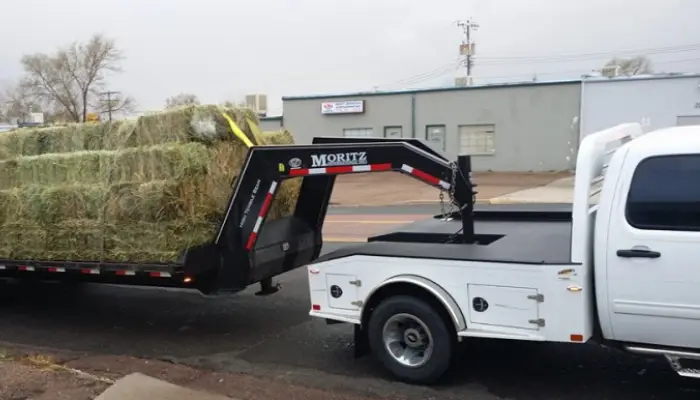This post may contain affiliate links which means I may receive a small commission for purchases made through the links. Learn More
Installing a gooseneck hitch on your pickup truck is a great way to increase its towing capacity and make it more versatile. With a gooseneck hitch on your pickup truck, you’ll be able to tow heavier trailers with ease. But many people don’t know how to install a Gooseneck hitch.
This guide is going to help you learn the complete installation process. Here are the steps that you will have to follow to complete the process of installing the gooseneck hitch.
- Measure your truck bed
- Locate the center of your truck bed
- Mark the holes’ locations
- Drill pilot holes
- Install the mounting plates
- Attach the gooseneck ball
- Test the hitch installation
It was a summary of the installation process, but I suggest you read the whole article so that you don’t miss any information and don’t make a mistake while installing the hitch. Let’s get started!
Related Article: How to Hook Up Gooseneck Trailer?
What are Gooseneck Hitches and how is it different from other types of hitches?
Before going down to the hitch installation process, I would like you to know the basics of gooseneck’s hitch and how it helps the users.
It is a type of towing hitch that is designed for use with full-size pickup trucks. It is a highly versatile and secure hitch that is ideal for towing heavy trailers, such as horse trailers, RVs, and large cargo trailers.
Gooseneck hitches differ from other types of hitches in several key ways. In the section below, I will give you some information that will help you distinguish the gooseneck hitches from other types of hitches.
- Gooseneck hitches are mounted in the bed of the pickup truck, whereas other hitches, such as ball hitches and weight distribution hitches, are mounted at the rear of the vehicle.
- Gooseneck hitches typically have higher weight capacities compared to other hitches, allowing for the towing of larger and heavier trailers.
- Gooseneck hitches provide better stability and control of the sway.
- Gooseneck hitches are mounted closer to the ground, providing better clearance compared to other hitches, especially when navigating rough terrain.
Also Read: What are Different Types of Trailer Hitches and Classes?
Tools Need for Installing the Gooseneck Hitch
To install Gooseneck hitch, there are a few tools that you will need for installing the hitch. A few of them are listed below. Make sure to arrange these tools before you begin the process to avoid unnecessary delays.
- Hole saw
- Bolts
- Measuring tape
- Wrench or socket set
- A gooseneck hitch kit
- A socket set
- A center punch
- A drill bit set
If you are the owner of a Chevy 2500, then I have written a complete where I reviewed some top gooseneck hitches for Chevy 2500. Check it out.
Step-by-Step Guide: Installing the Hitch on Gooseneck
You now know about the tools that you’ll need to install the gooseneck hitch. In the below section, I will be talking about the step-by-step process that you can follow to get the job done.
Step 1 – Measure your truck bed
First of all, you’ll need to measure your truck bed to determine the size and location of the hitch. Make sure to take into account any obstacles such as wheel wells or fuel tanks, and avoid drilling into these areas.
Step 2 – Locate the center of your truck bed
Locate the center of your truck bed by measuring the distance from the front and rear of the bed, then mark the center point with a pencil. This is where the gooseneck hitch will be installed.
Step 3 – Mark the hole locations
Now, it is time to find the ideal for the hole. Keep in mind that you will have to find two locations. One for the hitch placement and the second for the whole. Using the center point, mark the hole locations for the hitch according to the instructions in your gooseneck hitch kit.
Step 4 – Drill pilot holes
Now, you will have to use a center punch and make a small indentation in each hole location to prevent the drill bit from slipping. Then, using a drill bit that is slightly smaller than the bolts, drill pilot holes in each of the marked locations. Keep in mind that a drill bit will be provided in the gooseneck hitch kit.
Step 5 – Install the mounting plates
Place the mounting plates over the pilot holes and secure them with the bolts provided in your hitch kit. Tighten the bolts with a socket and torque wrench to the specified torque in the instructions. You must read the user manual of the hitch to know the torque specification.
Step 6 – Attach the gooseneck ball
With the mounting plates in place, attach the gooseneck ball to the center of the plates, securing it with the bolts provided. Again, tighten the bolts with a socket and torque wrench and make sure that it does not remain loose. Once you have attached the gooseneck ball, now it is time to Attach the safety chains to the gooseneck ball and secure them to the truck bed using the provided hardware.
Step 7 – Test the hitch
With the installation complete, it’s time to test the hitch to make sure everything is secure and working properly. Connect a trailer to the gooseneck ball and drive the vehicle slowly to check if the hitch is working perfectly or not.
Also Read: How to Pull a Gooseneck Trailer With a Bumper Hitch?
What are some benefits of a gooseneck hitch over other hitches?
Look, every hitch is made for a specific purpose and you should do it according to its functionality. Similarly, the gooseneck hitch is also made for specific functionality. Everything made on this planet has both good and bad. In the section below, I will guide you about some benefits of using a gooseneck hitch.
- Gooseneck hitches provide more control over the trailer and its movements
- They are also good for reducing the risk of swaying and ensuring a smoother towing experience.
- Gooseneck hitches often have higher weight capacities compared to other hitches, allowing for the towing of larger and heavier trailers.
- The unique design of gooseneck hitches allows for a tighter turning radius, making them ideal for towing large and heavy trailers, especially in tight and confined spaces.
- Gooseneck hitches can be easily removed and stored when not in use, making them versatile and convenient to use.
Frequently Asked Questions
Yes, it is possible to install a gooseneck hitch yourself with the right tools and knowledge. However, if you are not experienced with this type of installation it is always recommended to seek professional help.
Gooseneck hitches are typically used with larger trailers, such as horse trailers, cargo trailers, and travel trailers. However, you can use a gooseneck hitch with any kind of trailer with ease.
The time it takes to install a gooseneck hitch can vary depending on the specific hitch, the vehicle it’s being installed on, and the experience and skill level of the person installing it. However, on average, it typically takes 2 hours to install a gooseneck hitch.
The cost of professional installation of a gooseneck hitch depends on many factors such as the cost of the hitch itself, the cost of labor, and the location of the installation. On average, professional installation of a gooseneck hitch can cost anywhere from $300 to $500.
Conclusion
Installing a gooseneck hitch on your pickup truck provides an amazing towing experience and helps you tow the very heavy trailer. In this article, I’ve given you a complete step-by-step process that will help you install the gooseneck hitch by yourself. I hope that this guide will be a great help to you.

I’m Ahmad – the owner of this website and the writer of this post. I’ve spent 15 years in the automotive industry, especially among the hitches. What you’re reading is the experience of my 15 years.

